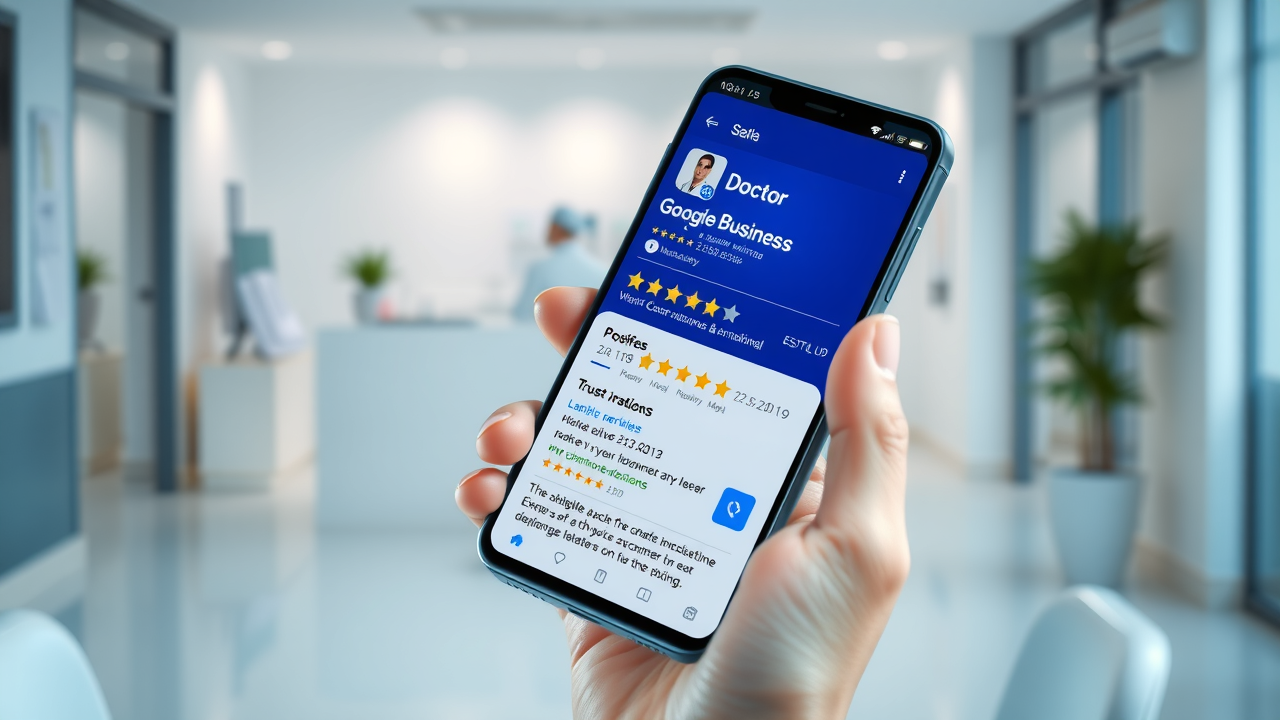
Did you know that over 77% of healthcare consumers search online before booking an appointment? If you’re not actively optimizing your medical practice marketing, you’re likely missing out on new patients every single day. The medical market is more competitive than ever, patient expectations are higher, and having a powerful marketing strategy is what separates thriving practices from those struggling to survive.
In this comprehensive guide, we’ll break down real-world marketing strategies, practical tips, and proven tactics to help your healthcare business stand out—whether you’re managing a small clinic or leading a multi-specialty group.
Unlock Growth: Why Medical Practice Marketing Matters More Than Ever
Medical practice marketing is not just a trend—it's an absolute necessity in today’s healthcare market. As patients increasingly turn to search engines and digital channels to choose their healthcare provider, your practice’s online reputation, visibility, and engagement strategies directly impact how many potential patients discover and choose your services. The vast majority of healthcare decisions now start online; your medical practice must meet this demand head-on by building an accessible and patient-centric presence.
Imagine a potential patient researching clinics in your area. If your website isn't optimized, your online reviews are sparse or negative, or you’re simply hard to find in local search results, you lose out to competitors who are marketing smarter. Success depends on leveraging multiple channels—from content marketing and social media to Google Business and review management—that work together to boost both trust and reach in the crowded healthcare market.
To maximize the impact of your content marketing efforts, consider how a single well-crafted blog post can be repurposed into multiple engaging formats. This approach not only extends your reach but also reinforces your expertise across different platforms.

Understanding the Healthcare Market: Trends Shaping Medical Practice Marketing Today
The healthcare market is evolving quickly, driven by both patient demand and technological innovation. The rapid adoption of telehealth has forced medical practices to rethink their patient journey and adjust medical practice marketing strategies to accommodate virtual visits and digital consultations. Practices that leverage telehealth as a feature in their marketing campaigns can better appeal to tech-savvy patients seeking flexibility and convenience.
The rise of patient-driven content marketing means clinics must provide educational blog posts and resources that address patient concerns in real time. Today’s patients expect transparency and actionable health advice long before they step foot in your door. Finally, regulatory updates regarding privacy, advertising compliance, and patient data are altering how medical marketing gets executed—requiring every healthcare provider to stay informed and adaptable to stay ahead in the medical market.

Essentials of Medical Practice Marketing: Core Strategies for Growth
Developing a Modern Medical Practice Marketing Strategy
Developing a modern medical practice marketing strategy means putting patient needs and the overall goals of your healthcare practice at the heart of every marketing decision. Start by mapping your target audience —what are their most common questions, concerns, and preferred channels for healthcare information? This data should drive your marketing efforts, shaping everything from your website content to your social media campaign messaging.
A well-rounded marketing strategy relies not on a single channel but on the synergy of social media, content marketing, online reputation management, and ongoing patient engagement initiatives. Today’s successful healthcare provider must be persistent, flexible, and data-driven, adjusting tactics quickly in response to trends in the healthcare market. Regularly review and update your approach, using ongoing feedback and marketing metrics to refine your patient acquisition and retention plans.
Allocating Your Marketing Budget for Maximum Impact
Your marketing budget is the backbone of your practice marketing strategy. Whether you’re a small clinic in a local neighborhood or a multi-specialty group in a metro area, allocating your costs across multiple channels—like paid search, organic SEO, social media, and content—ensures broader reach and more stable patient growth. For most practices, dedicating 2-10% of gross revenue to marketing is recommended, though your numbers may shift depending on specialty, competition, and growth targets.
Strategically balancing your marketing budget helps minimize risk and optimize for the best return on investment. For example, smaller practices might prioritize low-cost social media engagement and organic blog posts, while larger practices may dedicate more resources to paid search or high-quality video production. No matter your size, continually reassess which marketing channels produce the highest ROI and be ready to shift budget accordingly. Every marketing campaign should have clear goals, measurable metrics, and a set timeline for evaluation.
Comparative Marketing Budgets for Small, Medium, and Large Medical Practices | |||
Practice Size |
Channel Focus |
Typical ROI |
Budget % Allocation |
|---|---|---|---|
Small (1-3 providers) |
Local SEO, Social Media, Email, Blog Posts |
Moderate—great for community reach and loyalty |
2-5% |
Medium (4-10 providers) |
SEO, PPC, Content Marketing, Reviews |
High—supports wider local and regional visibility |
5-8% |
Large (11+ providers) |
Omnichannel: Paid Ads, Video, Advanced Analytics |
Potentially Very High—brand awareness and scaling |
7-10%+ |
Using Content Marketing and Blog Posts to Engage and Educate
Content marketing, including regularly published blog posts, is a game-changer for medical practices striving to educate their patient base and showcase their expertise. Well-written, informative, and patient-focused blog content not only builds trust but also drives valuable organic traffic to your website through search engine optimization (SEO). Address common health concerns, emerging treatments, and patient success stories to position your medical clinic as a go-to resource in the healthcare market.
Measure the effectiveness of your content marketing efforts by tracking metrics like page views, average time on page, and patient conversion rates. Update your marketing strategy regularly based on these insights for continued growth. Engaging content builds loyalty, improves search results, and can be leveraged across multiple channels (newsletters, social media, and more) for increased ROI.

Digital Marketing Tactics: Boost Your Medical Practice Marketing Online
Your medical practice’s online presence is just as important as the care you deliver. Patients now rely on search engines, online reviews, and social media to make decisions about their healthcare providers. By leveraging key digital tools—such as Google Business Profiles, search engine optimization (SEO), and targeted paid ads—you can ensure your practice appears at the top of search results and stands out in a crowded market. These tactics not only increase visibility but also position your practice as accessible, modern, and patient-centered.
Beyond visibility, engagement is critical. Platforms like Facebook, Instagram, and LinkedIn give your practice a space to share patient success stories, promote health education, and build trust through authentic, consistent communication. Coupled with online review management and reputation-building strategies, these digital tools transform your website and social channels into patient acquisition engines. When used strategically, they drive measurable results—higher appointment bookings, stronger patient loyalty, and sustainable growth for your practice.
Optimizing Google Business for Medical Practice Marketing Success
A well-optimized Google Business Profile is important for boosting your medical practice’s visibility in local search results. Claim your business profile, ensure all details are accurate, and include professional images of your clinic. Populate your profile with relevant keywords (like your medical specialty and location), highlight patient amenities, offer contactless booking options, and post regular updates about your healthcare practice or services.
Encourage satisfied patients to leave positive reviews—it’s a simple yet powerful way to climb search rankings and drive more potential patients to your practice. Utilize posts and FAQs within Google Business to address common queries and demonstrate your expertise, giving you a leg up on local competitors in the healthcare market.
Mastering Online Reviews for Medical Practice Growth
Online reviews are a make-or-break factor in medical practice marketing. Prospective patients rely heavily on reviews found in search results to determine which healthcare provider is reputable and trustworthy. Proactively requesting feedback from happy patients and making it easy to leave positive reviews (via follow-up emails, staff reminders, and QR codes in the office) will significantly boost your practice’s credibility and online presence.
Always respond to both positive and negative feedback to show you value your patients and are committed to ongoing service improvements. Patterns in reviews are especially valuable—address recurring issues and highlight top strengths in your marketing campaigns. The medical practices that listen, respond, and act on online reviews consistently outperform those that don’t.

Leveraging Social Media: Engage Audiences with Medical Practice Marketing
Social media is one of the most cost-effective and high-impact ways for medical practices to attract, educate, and build relationships with potential patients. Choose platforms based on your audience—Facebook and Instagram for broad community outreach, LinkedIn for professional connections, and Twitter for timely updates and engagement. Share regular posts that educate, answer common health queries, spotlight clinic news, and introduce new providers or services.
Ensure all your social media campaigns comply with patient privacy regulations (like HIPAA). Never share identifiable patient information without clear written consent. Creative use of infographics, explainer videos, and interactive Q&As can boost engagement and strengthen your brand across platforms.
Creating Engaging Content to Strengthen Your Practice Brand
Consistent, engaging content is key to standing out in today’s crowded healthcare market. Leading practices share patient stories (anonymized), daily health tips, wellness webinars, and behind-the-scenes photos to humanize their brand and build trust. Experiment with multiple content types—short-form videos for TikTok and Instagram, infographics for Facebook, and blog post teasers on LinkedIn—to broaden your reach and attract new patient segments.
Monitor which types of social media posts earn the most engagement, then use these insights to shape future marketing campaigns. Over time, a strong presence across social platforms translates to increased brand awareness, new patient inquiries, and greater loyalty from your existing patient base.

Website Optimization: Make Your Medical Practice Marketing Stand Out
If your medical practice website doesn’t appear in the top search engine rankings, potential patients may never discover your clinic. Conduct in-depth keyword research to target the phrases and queries that your potential patients are using. Optimize each page for a focus keyword (like “urgent care near me” or “pediatrician in [your city]”) and apply local SEO strategies by including your city, state, and neighborhood.
Technical SEO is just as vital—ensure your website loads quickly, is mobile-friendly, and uses secure (HTTPS) connections. Create search-engine-friendly meta tags, use schema markup for reviews and provider information, and routinely audit for broken links or outdated content. These technical elements work together to maximize your website’s visibility and credibility in the medical market.
Converting Visitors into Patients with User-Friendly Website Design
A beautiful website means little if it can’t convert visitors into booked patients. Ensure your medical practice website offers easy navigation, clear service descriptions, prominent calls to action (“Book Appointment”), and mobile-responsive layouts. Integrate secure, HIPAA-compliant online booking systems that make it fast and convenient for new patients to schedule visits—this alone can double or triple conversion rates.
Other must-haves include quick-loading pages, live chat or virtual assistant features, testimonials, staff bios with credentials, and clear insurance/payment instructions. Invest in website analytics to monitor where patients drop off or get stuck, then refine your design and content for continual improvement.

Practice Growth: Data-Driven Decisions in Medical Practice Marketing
To achieve sustainable practice growth, monitor key performance indicators (KPIs) such as new patient appointments, calls, website traffic, cost-per-lead, online bookings, and review ratings. Tools like Google Analytics, call tracking software, and CRM platforms give you clarity on which marketing strategies drive real results.
Regularly review analytics dashboards to identify successful channels and underperforming campaigns. This data-driven approach ensures your marketing budget is allocated to the most effective activities and allows you to adapt your messaging as patient behavior shifts in the healthcare market.
Iterative Improvements for Sustained Practice Growth
Lasting success in medical practice marketing is built on ongoing improvement. Test new ideas with A/B campaigns—like different ad copy, website landing page designs, or email subject lines—to see what resonates best with your target audience. Adjust your marketing budget quarterly based on performance and emerging trends in the medical market.
Stay proactive by subscribing to healthcare marketing news, participating in webinars, and soliciting patient feedback. Continuous learning ensures your strategies evolve alongside the rapidly changing healthcare profession.

Comprehensive Medical Practice Marketing Checklist
A strong marketing strategy requires consistency and regular evaluation. Use this checklist to ensure your medical practice stays visible, patient-focused, and competitive.
Monthly Tasks
Every month, focus on activities that maintain your online presence and strengthen patient engagement. Review your website analytics to understand traffic sources, popular pages, and conversion trends—this helps you see what’s working and where improvements are needed. Publish fresh blog content to boost SEO and demonstrate thought leadership, while also providing helpful resources for patients. Stay active on social media with posts, health tips, and updates that keep your audience engaged. Update your Google Business Profile with posts, offers, or announcements to improve local visibility. Most importantly, respond to online reviews in a timely and HIPAA-compliant manner to show patients you value their feedback.
Quarterly Tasks
Each quarter, take a deeper look at your marketing performance. Audit your SEO and website performance to ensure your site is fast, mobile-friendly, and ranking for relevant keywords. Review ROI from different marketing channels—such as paid ads, social media campaigns, and referral programs—to identify what brings the best results. Run A/B tests on website pages, calls-to-action, or ads to fine-tune your messaging and boost conversion rates. Refresh your marketing collateral, including brochures, digital assets, and email templates, to keep them up-to-date and aligned with your brand. Finally, hold a team brainstorm to discuss new ideas, review patient feedback trends, and uncover opportunities for growth.
Annual Tasks
Once a year, zoom out to evaluate your overall strategy. Reassess your marketing budget to ensure resources are being allocated effectively, and adjust based on past performance data. Update your strategic plan for the new year, taking into account changes in patient behavior, new healthcare regulations, or market trends. Set new KPIs (key performance indicators) that align with your practice’s goals—whether that’s increasing new patient acquisition, boosting retention, or expanding into new service areas. An annual review ensures your marketing efforts remain proactive and aligned with the evolving healthcare landscape.

Take Charge of Your Medical Practice Marketing Today
In today’s digital-first healthcare environment, medical practice marketing is no longer optional—it’s the foundation for sustainable growth and long-term patient trust. From optimizing your website and managing online reviews to leveraging social media and refining your Google Business presence, every strategy in this guide works together to expand your reach and strengthen your reputation. Practices that act now not only stand out in crowded markets but also build a patient-centered brand that thrives for years to come.
The key to success lies in consistency, adaptability, and measurement. Marketing isn’t a one-time campaign—it’s an ongoing commitment to meeting patient expectations where they are, whether online, in your community, or through the stories you share. By following the proven strategies, checklists, and digital tools outlined here, your practice can unlock real growth, attract more patients, and deliver care that resonates beyond the clinic walls. The future of your practice begins with the steps you take today.

Frequently Asked Questions on Expert Medical Marketing
Why is medical practice marketing important for my clinic?
Medical practice marketing helps you attract new patients, retain existing ones, and strengthen your clinic’s reputation. In today’s digital-first world, it ensures your services are visible, competitive, and aligned with patient expectations.
What digital tools are most effective for healthcare marketing?
Key tools include a well-optimized website, Google Business profile, online reviews, SEO, social media platforms, and targeted paid ads. Together, these channels help your practice connect with patients where they are most active online.
How often should I review and update my marketing strategy?
You should review analytics and performance monthly, audit your strategy quarterly, and update your overall marketing plan annually. This ensures your efforts remain effective and aligned with healthcare market changes.
Can a small practice with a limited budget still succeed in marketing?
Yes! With the right approach, even practices with modest budgets can see growth. Strategies like content marketing, online reviews, and local SEO are cost-effective and provide strong results over time.
How do I measure the success of my marketing campaigns?
Tracking KPIs such as website traffic, patient inquiries, appointment bookings, and ROI from each channel will show which tactics are working. Regular analysis helps you refine efforts and avoid wasted spend.

Elevate Your Medical Practice Marketing Now
Ready to take your clinic’s growth to the next level? Start applying proven medical practice marketing strategies today to attract more patients, build trust, and stay ahead of the competition. From optimizing your online presence to leveraging reviews and digital tools, every step you take brings measurable results. Don’t wait—put these tactics into action now and watch your practice thrive.
 Add Row
Add Row  Add
Add 




Write A Comment